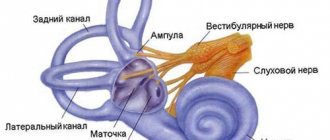A description is given of the forms of hydrocephalus that can be incidental findings on MRI/CT of the brain - primary hydrocephalus and conditions with which a differential diagnosis must be made. Information about benign intracranial hypertension (BIH), normotensive and replacement hydrocephalus is presented to the extent that is necessary for a neurologist in outpatient practice to make decisions and explain to the patient the essence of his condition. The structure of the document reflects the tasks facing it. You can get acquainted with the question in more detail using the links in the relevant sections of the text. The clinical picture of intracranial hypertension consists of general cerebral and focal symptoms. Intracranial hypertension is characterized by the absence of pathognomonic disorders. In a typical clinical picture, a triad stands out: headache, vomiting, congestion in the fundus. Increased intracranial pressure is often associated with hydrocephalus, a disorder involving the accumulation of excess cerebrospinal fluid (CSF) in the cerebral ventricles and/or subarachnoid spaces, due to an imbalance between secretion and absorption, which is accompanied by dilation of the ventricles and/or subarachnoid spaces. The set of disorders in patients may be similar to the clinical picture of other lesions of the nervous system: - disseminated demyelinating focal lesions of the brain substance and cranial nerves, - focal lesions of the brain stem with involvement of the medial longitudinal fasciculus and the development of disorders of consciousness - space-occupying formations of the brain with general cerebral changes, focal symptoms and symptoms of damage to the cranial nerves, - conditions with diffuse brain damage - encephalopathy. — neuroinfections (congenital syphilis, cytomegalovirus infection, mumps, etc.) — thrombosis of the sinuses and veins of the brain. Asymptomatic cases of intracranial hypertension (ICH) are accompanied by nonspecific complaints - dizziness, fatigue. The variety of variants of the clinical picture, both in severity and in the set of symptoms, is the reason for the overdiagnosis of hypertensive-hydrocephalic syndrome, both in adult and pediatric neurological practice. An additional harmful effect is the high rate of false-positive data on dilation of the ventricular system when using echoencephaloscopy. Doctors can claim that a patient has ICH if rheoencephalography, duplex scanning of the brachiocephalic arteries, or transcranial Doppler sonography reveals venous drainage from the cranial cavity.
Imaging signs of hydrocephalus with increased ICP include: An increase in the size of the inferior horns of the lateral ventricles by more than 2 cm with the absence of visualization of the subarachnoid spaces of the convexital areas, interhemispheric and lateral fissures of the brain; Balloon-shaped dilatation of the anterior horns of the lateral ventricles (Mickey Mouse symptom) and the third ventricle; Periventricular decrease in tissue density seen on CT or increased T2 signal seen on magnetic resonance imaging (MRI) as a result of transependymal infiltration or migration of cerebrospinal fluid. In addition to structural changes, the clinical manifestations of hydrocephalus are taken into account. The last clarification is necessary, since taking into account only structural changes does not allow us to classify disorders of liquorodynamics without changing the configuration of the ventricles as hydrocephalus, for example, benign intracranial hypertension (BIH).
What is intracranial pressure
Intracranial pressure is the force with which cerebrospinal fluid presses on the ventricles of the brain. It's called liquor. The pressure of excess fluid or lack of it causes pain.
Liquor protects the brain from mechanical damage. Fluid circulates from the ventricles of the brain to the spinal ventricle. There are situations when cerebrospinal fluid accumulates in some sections. For this reason, ICP increases.
Intracranial pressure and blood pressure may change together. ICP is a dangerous condition, sometimes life-threatening. Pathology can strike at any age. Infants and adults face this.
Symptoms of intracranial pressure
A distinctive feature of the disease, which makes it possible to identify intracranial pressure as the main cause of headaches, is the vivid manifestation of symptoms in the morning. In a lying position, pulsating pressure occurs in the temple area. The main symptoms of ICP are:
- headaches in one part of the head, usually temporal or occipital;
- nausea;
- dizziness;
- decreased vision;
- sweating;
- drowsiness;
- fatigue, apathy;
- surges in blood pressure.
Coughing or sneezing makes the pain worse. Decreased vision depends on the degree of pressure. In dangerous cases, complete blindness occurs. Other manifestations may include the following:
- swelling of the eyelids;
- bruises under the eyes;
- hearing loss;
- noise in ears;
- increased salivation;
- pain in the heart or stomach.
Signs of pathology
ICP is not an independent disease and is only a consequence of the development of the underlying disease. Based on this, you need to understand that the increase in pressure will occur quite slowly, and the symptoms characteristic of this pathology will appear gradually and in an increasing manner.
Headache attacks periodically occur in anyone, even the healthiest person. But this does not mean at all that intracranial pressure has increased. High intracranial pressure has characteristic symptoms:
- Headache. It can be localized in any part of the head and will have a pressing or bursting character. A person feels headaches most strongly in the morning. This occurs as a result of the fact that at night the outflow of cerebrospinal fluid worsens, since the person was in a horizontal position.
- Deterioration of vision. This process can be of a different nature:
- peripheral vision is impaired;
- pupils become different sizes;
- low pupil reaction to light;
- splitting of objects;
- fogging and even temporary blindness.
These problems occur due to increased pressure on certain optic nerves.
- Unreasonable nausea and vomiting.
- Symptom of the so-called “setting sun”. A person cannot close his eyes due to a protruding eyeball.
- Dark circles under the eyes. This occurs due to excessive filling of the veins of the lower eyelid with blood, which can be seen upon close examination.
- Complete loss of strength and irritability.
- Mood swings leading to depression.
- Pain in the back.
- Constant lack of air.
Causes of high blood pressure in adults
Symptoms of intracranial pressure are not specific. Similar signs may indicate other diseases. A study is required to make a diagnosis. ICP appears at any age. Adults, as a rule, have concomitant diseases that are causes of ICP:
- The presence of tumors in the brain.
- Circulatory disorders.
- Severe poisoning.
- Overweight.
- Excessive intake of vitamin A.
- Migraine.
- Encephalitis.
- Hydrocephalus.
- Meningitis.
- Stroke.
- Brain hypoxia.
- Thrombosis of the venous sinuses.
- Traumatic brain injuries.
- Late toxicosis of pregnant women.
These causes do not always lead to ICP, but their presence increases the risk of developing the disease.
NORMOTENSIVE HYDROCEPHALUS
Normal pressure hydrocephalus (NPH) is associated with impaired CSF absorption, and dilatation of the cerebral ventricles develops in the presence of normal intracranial pressure.
EPIDEMIOLOGY
The prevalence of NG is 1-2 cases per 1,000,000 people. In the practice of a neurologist specializing in patients with extrapyramidal diseases, as a rule, no more than a dozen patients are recorded per year. This type of hydrocephalus is more common in older people. The condition should be excluded in persons over 60 years of age with a combination of cognitive impairment (dementia), pelvic organ dysfunction (usually urinary incontinence) and walking impairment (lower body parkinsonism) - the Hakim-Adams triad. Due to the fact that in a significant proportion of cases, bypass surgery in the early stages leads to improvement in walking, it is important to suspect and confirm this condition in a timely manner.
CLINIC
The structure of cognitive impairment is dominated by frontal-subcortical disorders: decreased activity, apathy, and behavioral disorders. Walking disorders have been described as magnetic gait, gait apraxia, and frontal ataxia. Patients experience the greatest difficulty when starting to walk. The area of support is increased, the length and height of the step is reduced, the smoothness of movements is impaired, and there is a progressive slowdown in walking with each step. Patients always have postural instability; often, upon questioning, you can find out that there have been falls before.
DIFFERENTIAL DIAGNOSIS
However, other diseases with cognitive and motor impairments may have a similar pattern of impairments. When carrying out differential diagnosis, the following are considered: vascular dementia (discirculatory encephalopathy stage III), Parkinson's disease with dementia and dementia with Lewy bodies, Alzheimer's disease. The main diagnostic method is MRI of the brain. The examination reveals the expansion of the lateral ventricles, the rounded shape of their anterior horns, and the smoothness of the relief of the cerebral cortex. It is important to use the Evans ventricular-hemispheric index, which is the ratio of the distance between the most distant points of the anterior horns of the lateral ventricles to the largest internal diameter of the skull. Ventriculomegaly is diagnosed if the index exceeds 0.31. NG is characterized by changes in the periventricular white matter, similar to leukoaraiosis (see above). Their severity correlates with the degree of cognitive impairment].
Figure 2 MRI signs of cerebral atrophy (A) in Alzheimer's disease and (B) normal pressure hydrocephalus
At first glance, the images are quite similar, but the image on the right shows the rounded shape of the horns of the lateral ventricles and the smoothness of the sulci of the cerebral hemispheres.
Figure 3 Gliotic and atrophic changes after traumatic brain injury, replacement hydrocephalus
Intracranial pressure in children
In children, ICP can occur in the womb. The reasons for this are the following:
- disturbance in brain development;
- improper outflow of cerebrospinal fluid;
- infections that the baby contracted in utero;
- excessively rapid closure of the fontanel;
- hypoxia during childbirth, causing cerebral edema;
- hydrocephalus;
- trauma during childbirth;
- difficult course of labor.
A neonatologist knows how to determine intracranial pressure in a newborn. A timely diagnosis allows the child to develop without any problems. Up to 2 years, ICP may temporarily increase due to the following factors:
- weather changes;
- prolonged crying;
- with significant physical activity.
Diagnosis of intracranial pressure in an infant is carried out in the presence of the following symptoms:
- unexpected scream;
- frequent crying at night;
- irritability;
- aggression;
- bright veins on the head;
- head growth is not proportional to age;
- drowsiness, lethargy, apathy;
- bulging fontanel;
- eyes are always lowered;
- trembling;
- delayed physical or psychological development;
- refusal to eat;
- regurgitation.
After the age of 3 years, signs of ICP are:
- frequent headaches at night and in the morning;
- nausea;
- developmental delay;
- decreased vision;
- lack of coordination;
- large forehead;
- walking on tiptoe.
With a sharp jump in intracranial pressure, vomiting, fainting, and convulsions occur. Diagnosis of intracranial pressure in children is carried out as follows:
- Measuring head circumference. Its rapid growth and inconsistency with age indicate brain disease.
- An examination of the fundus by an ophthalmologist can identify disorders of the optic nerve that occur with ICP.
- If the fontanelle is open, an ultrasound scan of the brain is performed. For older children, computer or magnetic resonance imaging is used.
- Doppler ultrasound can detect vascular disorders.
- In newborns, intracranial pressure can be determined using the Ladd monitor. It reveals pulsation in the crown.
Symptoms
Manifestations of pathologies arise due to a malfunction of the central nervous system, provoked by increased pressure on the medulla.
| Age groups | Manifestations |
| Infants |
|
| Older children and adults |
|
Diagnostic methods
Faced with frequent headaches, people do not know where to go and which doctor measures intracranial pressure. The main observation of the patient is carried out by a neurologist, because this pathology affects the central nervous system. Additionally, you will have to visit an ophthalmologist for a fundus examination.
Intracranial pressure can be determined by two methods:
- invasive;
- non-invasive.
The first is a direct method, requiring sterile conditions, expensive equipment and highly qualified physicians.
Non-invasive ones have become widespread due to their safety and reliability. Allows you to identify changes in the structure of the brain. Detect tissue neuroactivity.
How to relieve symptoms of increased ICP at home?
The condition of persistent increase in intracranial pressure is most dangerous for children, especially when their age does not exceed 3 years.
During childhood, brain structures grow and develop rapidly, and neural connections progress. If during this period the brain is compressed, this will affect nutrition, the progression of brain structures, and in severe cases can cause direct damage to the brain structures as a result of compression. Signs that should alert parents and serve as a reason for an emergency examination by a neurologist: constant restlessness of the child, frequent crying, irritability, poor appetite, divergence of cranial sutures, and in infants - bulging of open fontanelles. Older children may complain of pain behind the eyes and in the frontal lobe, which may radiate to the ears and back of the head.
A common symptom is blurred vision, visual abnormalities in the form of flashes of light in front of the eyes, dark spots or bands. In the later stages, symptoms of exophthalmos are observed, Graefe's symptom is the presence of a white strip of sclera between the upper edge of the iris and the upper eyelid, as well as spontaneous movements of the eyeball.
It is somewhat easier to check whether the level of pressure inside the skull in children corresponds to the age norm than in adults, due to the large number of cartilaginous elements in the skull, but this is impossible to do at home due to the need to use special devices.
Which doctor can diagnose? Neurologist. To do this, resort to the following methods:
- neurosonography - ultrasound of the skull and brain structures, which is suitable for children with an open fontanel. The method allows you to determine the state of the midline structures of the brain, its ventricles filled with cerebrospinal fluid, and their displacement depending on the force of pressure. Then, based on the presence of displacement of certain structures, using special algorithms, a conclusion is made about the value of intracranial pressure;
- Doppler sonography - allows you to visualize blood circulation in the vessels of the patient’s brain, with its help you can evaluate all the rheological properties of blood - from thickness to flow rate. Using the resulting data, the pressure in the cranium is determined by calculation;
- otoacoustic method - after measuring the amount of outward displacement of the eardrum, the measurement result is interpreted into the value of intracranial pressure.
In addition, CT (computed tomography) and MRI (magnetic resonance imaging) results can be used to measure ICP.
When intracranial pressure increases, symptoms typically include a number of commonly observed signs:
- headache,
- visual disturbances,
- dizziness,
- absent-mindedness,
- memory impairment,
- drowsiness,
- instability of blood pressure (hypertension or hypotension),
- nausea,
- vomit,
- lethargy,
- fast fatiguability,
- sweating,
- chills,
- irritability,
- depression,
- mood swings,
- increased skin sensitivity,
- pain in the spine,
- breathing disorders,
- dyspnea,
- muscle paresis.
If you occasionally experience any of these signs, then, naturally, this is not evidence of increased intracranial pressure. Symptoms of increased pressure inside the skull may be similar to symptoms of other ailments.
The most common symptom indicating the disease is headache. Unlike migraine, it affects the entire head at once and is not concentrated on one side of the head. Most often, pain with high ICP is observed in the morning and night hours. Pain with increased intracranial pressure can intensify when turning the head, coughing, sneezing. Taking analgesics does not help relieve pain.
The second most common symptom of increased intracranial pressure is problems with visual perception - double vision, blurred objects, decreased peripheral vision, attacks of blindness, fog before the eyes, decreased reaction to light. These signs of increased intracranial pressure are associated with compression of the optic nerves.
Also, under the influence of increased ICP, the shape of the eyeball may change in the patient. It may bulge so much that the patient is unable to close the eyelids completely. In addition, blue circles made up of congested small veins may appear under the eyes.
Nausea and vomiting are also common symptoms of increased intracranial pressure. As a rule, vomiting does not bring relief to the patient.
It should be borne in mind that intracranial pressure can briefly increase (2-3 times) even in healthy people - for example, when coughing, sneezing, bending, physical activity, stress, etc. However, the ICP should quickly return to normal.
To directly measure pressure inside the skull, complex instrumental methods that require highly qualified physicians, sterility and appropriate equipment are used, which are often unsafe. The essence of these methods is puncture of the ventricles and insertion of catheters into the areas where cerebrospinal fluid circulates.
A method such as puncture of cerebrospinal fluid from the lumbar spine is also used. In this case, both pressure measurements and a study of the composition of the cerebrospinal fluid can be carried out. This method is necessary if there is reason to suspect the infectious nature of the disease.
As a result of these studies, it is possible to identify changes in the structure of the brain and surrounding tissues, indicating increased intracranial pressure.
These changes include:
- increase or decrease in the volume of the ventricles of the brain,
- swelling,
- increasing the space between the shells,
- tumors or hemorrhages,
- displacement of brain structures,
- dehiscence of the sutures of the skull.
Encephalography is also an important diagnostic method. It allows you to determine disturbances in the activity of various parts of the brain characteristic of increased ICP. Doppler ultrasound of blood vessels helps to detect blood flow disturbances in the main arteries and veins of the brain, congestion and thrombosis.
An important diagnostic method is fundus examination. In most cases, it can also detect increased intracranial pressure. With this syndrome, symptoms appear such as enlargement of the vessels of the eyeball, swelling of the place where the optic nerve approaches the retina, and small hemorrhages on the retina. After determining the degree of development of the disease, the doctor must inform the patient about how best to treat it.
What causes increased ICP in an adult? Here we must take into account that increased intracranial pressure is usually a secondary symptom and not an independent disease.
Factors that can lead to increased intracranial pressure include:
- skull and brain injuries;
- inflammatory processes of the brain and meninges (encephalitis, meningitis);
- obesity;
- hypertension;
- hyperthyroidism;
- dysfunction of the adrenal glands;
- liver pathologies causing encephalopathy;
- osteochondrosis of the cervical spine;
- tumors in the head area;
- abscess;
- cysts;
- helminthiasis;
- stroke.
Also, increased intracranial pressure can appear as a result of infectious diseases, such as:
- otitis,
- bronchitis,
- mastoiditis,
- malaria.
Another possible cause of the syndrome is taking certain medications.
These include:
- corticosteroids,
- antibiotics (primarily biseptol and tetracyclines),
- hormonal contraceptives.
Factors leading to high intracranial pressure can either provoke increased generation of cerebrospinal fluid, disrupt its circulation, or interfere with its absorption. Three mechanisms for the occurrence of the syndrome may occur at once.
Hereditary predisposition to this disease should also be taken into account. In infants, the main factors contributing to the onset of the disease are birth injuries, fetal hypoxia, toxicosis during pregnancy and prematurity.
The following signs may include:
- Constant fatigue, lethargy.
- A state of nervous tension and irritation: to light, noise, other people.
- Nausea attacks may occur along with vomiting.
- Deterioration of vision, hearing, and memory.
- Blood pressure surges.
- Increased sweating.
There are many reasons for increased ICP that lead to the appearance of symptoms of the disease. They can differ significantly in children and adults.
Signs of increased ICP in children:
- Swelling and pulsation of the large and small fontanelles.
- A slight wobble of the chin.
- Dehiscence of the sutures of the cranial vault.
- Visual impairment.
- Strabismus may occur due to impaired oculomotor function.
- Seizures.
- Profuse regurgitation.
Increased ICP can lead to two cases:
- Gradual appearance of signs of the disease.
- Spontaneous onset of symptoms, in which consciousness is impaired and a coma occurs. Death occurs in 92% of cases.
What doctors say about hypertension
Doctor of Medical Sciences, Professor Emelyanov G.V.:
I have been treating hypertension for many years. According to statistics, in 89% of cases, hypertension results in a heart attack or stroke and death. Currently, approximately two thirds of patients die within the first 5 years of disease progression.
The next fact is that it is possible and necessary to reduce blood pressure, but this does not cure the disease itself. The only medicine that is officially recommended by the Ministry of Health for the treatment of hypertension and is also used by cardiologists in their work is Normaten. The drug acts on the cause of the disease, making it possible to completely get rid of hypertension. In addition, within the framework of the federal program, every resident of the Russian Federation can receive it for FREE.
- First of all, you need to calm down - today medicine has many ways to solve this problem.
- Next, you should contact a specialist (neurologist), who will prescribe the necessary procedures to identify the degree of advanced disease.
- And finally, it is necessary to follow all the instructions of the attending physician to effectively combat and restore health.
- Jogging helps bring blood pressure back to normal. It is important to even out your breathing while running. Gymnastics, swimming, walks in the fresh air and other increased activity will also help.
- Excess weight is the cause of increased ICP, which needs to be eliminated. You need to start leading a healthy lifestyle and instill proper eating habits. Consume less fried, fatty and salty foods and more fruits and vegetables.
- It is recommended to place a thin pillow under your head before going to bed at night, which will not press on the neck veins and impair the blood supply to the brain.
- Massages of the head and collar area help improve well-being and blood circulation.
- You need to quit bad habits. Nicotine has a vasoconstrictor effect, which impairs blood flow.
| MYTH | IS IT TRUE |
| Patients with increased ICP notice improvement with age, and then complete recovery. | The constant influence of accumulated cerebrospinal fluid provokes exacerbations listed earlier. |
| Increased ICP is a disease that has no cure. | Today, there are many ways to treat increased ICP, both with medication and with surgery. |
| Increased ICP is a hereditary disease. | No research confirms such a connection. |
| Children with increased ICP are lagging behind in mental development. | The level of intracranial pressure does not affect the development of the child in any way. |
| ICP can only be stabilized with the help of medications. | Some cases require surgery (catheter insertion, bypass surgery) |
Invasive methods
Invasive methods for diagnosing intracranial pressure in adults are carried out as follows:
- A catheter is inserted into the ventricle of the brain and fluid is withdrawn. The information content of this method is the highest.
- The use of a subdural screw is indicated in emergency cases. The procedure is complex and risky. A screw is inserted through a special hole in the skull to determine the ICP.
- The intraventricular method allows you to measure ICP through a special hole in the skull. If necessary, the cerebrospinal fluid can be pumped out.
- The epidural method allows you to determine the level of pressure, but does not remove excess fluid.
- Intraparenchymal sensors consist of a thin wire. The method is the least traumatic. Allows you to control ICP in a hospital setting. But the method is not always reliable.
All methods carry a risk of developing infectious diseases. These methods are used when absolutely necessary.
Treatment of ICP
Doctors use a comprehensive approach to treating increased intracranial pressure. Most often this is:
- taking medications. Most often these are diuretics. For example, Diakarb. The drug acts not only as a diuretic, but also affects carbonic anhydrase in the medulla. As a result, the formation of cerebrospinal fluid in the skull is reduced. Other proven drugs are the diuretic Furosemide, the hormonal agent Dexamethasone, the osmodiuretic Mannitol, the neuroprotector Glycine, etc.;
- medical punctures. Ventricular punctures and craniotomies help reduce cerebrospinal fluid pressure by diverting it;
- manual therapy, hyperventilation, controlled hypotension, hyperbaric oxygenation;
- food selection. The main recommendation is to review your diet and adjust your daily menu with foods rich in vitamins and nutrients. Additionally, you should minimize the amount of salt consumed and monitor the amount of fluid consumed;
- physical exercise.
Treatment depends on the patient's age and the causes of the disease. An aneurysm, brain tumor, or traumatic brain injury requires surgery. It is important to establish the true cause of increased pressure in the skull. You must consult your doctor about all activities. Self-medication is fraught with serious consequences.
Children diagnosed with ICP as a result of hydrocephalus are operated on to drain excess cerebrospinal fluid.
Traditional methods of treating ICP
The most accessible means for lowering intracranial pressure is taking diuretic decoctions, foods, juices and teas. For example, with ICP:
- drink a decoction of lingonberry leaves;
- Apply a compress with camphor oil and alcohol overnight. The components are mixed in equal parts and applied to a cloth that is applied to the head. The head is additionally wrapped in polyethylene. The procedures are performed in courses of 10 days;
- use an infusion of lemon and garlic. 1 lemon and 1 head of garlic are crushed through a meat grinder and mixed thoroughly. Pour the slurry with 1 liter of boiled chilled water. Take 2 tablespoons daily. Store the product in a cool place;
- make inhalations over brewed bay leaves. 30 leaves are brewed with boiling water, left for 5 minutes and breathed over the container, covered with a thick cloth for 15 minutes;
- They use a herbal infusion of hawthorn, mint, motherwort and valerian. Take herbs in equal parts and brew with boiling water. The broth is sealed and put in a dark place for 2 weeks. Then the liquid is filtered and a few drops are taken;
- take a bath with linden blossom. To prepare, take 4 cups of herbs in a 10-liter bucket of boiling water. After 15 minutes of infusion, the liquid is filtered and added to the total volume of water.
Non-invasive methods
How to determine intracranial pressure using non-invasive methods:
- By displacement of the eardrum. As ICP increases, it shifts due to the pressure of the endolymph in the cochlea of the hearing aid.
- Cochlear microphony is based on changing the vibrations of high-frequency sound. This method does not show pressure, but records its changes. Not used for traumatic brain injuries due to the lengthy examination.
- Transcranial Doppler ultrasound is an ultrasound method that allows you to determine the speed of blood flow through the vessels. Pulsation indirectly indicates the presence of high ICP. This method has no contraindications, but is incompatible with vascular drugs, alcohol and smoking.
- Examination of the fundus to detect swelling.
- Magnetic resonance imaging can determine the presence of intracranial pressure.
These methods have few contraindications and do not provide accurate results. Only invasive methods can determine whether ICP is normal. What is the normal level of intracranial pressure in adults? This is 10-15 mm Hg. Art. At 25 mm Hg. Art. the condition becomes dangerous, more than 35 - fatal.
Make a diagnosis
Intracranial pressure can be directly measured only by inserting a special needle with a pressure gauge connected to it into the fluid cavities of the skull or spinal canal. Therefore, we do not use direct measurement of intracranial pressure.
On the left is an MRI scan of a normal brain. The brain matter is shown in gray, the cerebrospinal fluid is in white. Normal size of the fluid spaces of the brain (they are slit-like). The ventricles are visible inside the brain. The subarachnoid spaces are the white border around the brain.
In the center there is internal hydrocephalus. Excessive accumulation of cerebrospinal fluid inside the brain in the form of a butterfly is visible. On the right is external hydrocephalus. External hydrocephalus is also an excessive accumulation of cerebrospinal fluid outside the brain in the form of a wide white border. The volume of the brain matter is reduced - brain atrophy from fluid pressure
We can confidently judge the increase in intracranial pressure based on the following data:
- Dilation and tortuosity of the fundus veins is an indirect but reliable sign of increased intracranial pressure;
- Expansion of the fluid cavities of the brain (internal hydrocephalus of the brain, external hydrocephalus) and external hydrocephalus (rarefaction of the medulla) along the edge of the ventricles of the brain, clearly visible on computed x-ray tomography (CT) or magnetic resonance imaging (MRI);
- Violation of the outflow of venous blood from the cranial cavity, established using ultrasound vascular studies.
How much the brain suffers from increased intracranial pressure can be judged from EEG data. The gold standard for instrumental examination of patients in our clinic is an assessment of symptoms, brain tomography , fundus images and EEG .
Good optics helps us see the subtle nuances of the fundus vessels
Echoencephalography (Echo-EG) provides indirect and not always reliable data on increased intracranial pressure; it is less reliable than CT and MRI, so we do not use this method.
Consequences of the disease in children
With a constant increase in intracranial pressure in children, the blood supply to the brain is disrupted and vasoconstriction occurs. This leads to developmental delays. With timely treatment, the disease does not affect the child’s future life. Without treatment, serious consequences are possible:
- mental disorders;
- stroke;
- speech disorder;
- physical lag behind peers;
- epilepsy;
- lack of coordination;
- hydrocephalus;
- paralysis;
- decreased vision;
- weakness;
- breathing disorder.
Intracranial pressure, which led to complications, leads the child to disability. In some cases, death occurs.
Causes
The pressure inside the head increases due to the following reasons:
- Volumetric processes in the brain: tumors, hygroma, foreign object in the cranial cavity, hydrocephalus in children.
- Pathological conditions: impaired outflow of cerebrospinal fluid, cerebral edema, stagnation of venous blood.
- Inflammatory diseases: encephalitis, meningitis.
- Acute conditions: hemorrhagic stroke, traumatic brain injury.
Treatment methods
A neurologist knows how to determine intracranial pressure and how to treat it. Depending on the cause of ICP and the age of the patient, an appropriate treatment regimen is selected. Diuretics, vascular and sedatives are used. Prescribe an appropriate diet and exercise.
Diuretics remove excess fluid from the body through the kidneys. Due to this, the amount of cerebrospinal fluid is reduced. Diuretics will not bring the desired result if the cause of ICP is a tumor, aneurysm or injury. In this case, surgery will be required. A doctor must prescribe medications. Self-medication is unacceptable.
If ICP is formed as a result of excessive formation of cerebrospinal fluid, then shunting is performed and the excess fluid is pumped out.
When treating with medications the following is used:
- diuretics;
- neuroprotectors;
- diacarb;
- hormonal drugs;
- drugs to reduce cerebrospinal fluid.
Limit salt intake to avoid fluid retention in the body. You should avoid fatty foods and give preference to plant foods rich in vitamins. Drink herbal teas that have a mild diuretic effect.
Reasons for development
Key causes of permanently increased intracranial pressure:
- changes in the patency of the pathways along which cerebral fluid moves;
- excess cerebrospinal fluid;
- changes in the outflow of cerebral fluid, its incomplete absorption.
Head trauma can cause intracranial pressure.
Factors that provoke increased intracranial pressure and the occurrence of hydrocephalus:
- injuries, bruises, fractures of the skull (generic, old), concussions;
- intracranial hematomas, cerebral hemorrhages;
- physical or emotional stress;
- tumors of the brain or its membranes, Arnold-Chiari malformation;
- pathologies of the endocrine system (hyperthyroidism, adrenal diseases);
- genetic characteristics of the central and peripheral nervous systems;
- overweight, excess vitamin A;
- stroke, aneurysm rupture, spasm, vasoconstriction;
- intoxication (alcohol, chemical, medication, toxic);
- pathology of the venous sinuses, cervical osteochondrosis;
- idiopathic intracranial hypertension, hypoxia;
- congenital anomalies of the brain and its vessels, ischemia;
- meningitis, encephalitis, vermiculitis, encephalopathy, meningoencephalitis;
- migraine, metabolic disorders, changes in blood circulation in the vessels of the brain;
- excess fluid in the body, parasitic infestation.
Prevention of ICP
To prevent intracranial pressure, the following rules should be followed:
- drink the amount of fluid recommended by your doctor;
- ensure intake of vitamins with food or complexes;
- walk more, ventilate the room;
- avoid heavy loads and stressful situations;
- engage in moderate physical activity;
- Night sleep should be at least 8 hours;
- avoid sudden changes in climate and time zones;
- do not fly by air;
- sleep on high pillows with your head elevated;
- get up immediately after waking up;
- If possible, massage the collar area.
Prevention and maintaining a healthy lifestyle is the best tool for avoiding complications with intracranial pressure.










